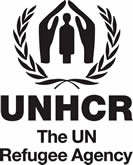Invisible in the City: the lives of urban refugees
Presented by Eckerd College and the Tampa Bay Refugee Task Force
In commemoration of Human Rights Day and in partnership with Eckerd College and Tampa Bay Refugee Task Force, the Studio@620 welcomes the United Nations High Commissioner for Refugees (UNHCR) photo exhibit "Invisible in the City: the lives of urban refugees" for its Florida debut December 7-11, 2010. This international touring photo project features compelling black-and-white photographs taken by Zalmaï Ahad, a former Afghan refugee.
All are invited to an exhibit reception on Thursday, December 9 from 4:30-6:30 PM. Highlights of the reception will include remarks by Hiram Ruiz, Director of Refugee Services for the Florida Department of Children and Families (DCF) and local refugees who will share their resettlement experiences and musical talent. Admission is free and open to the public. Exhibit on display December 7-11 during regular gallery hours, Tues-Sat 12-4 PM.
"Invisible in the City" opened at an event at the UN Headquarters in Geneva in December 2009. After it premieres in St. Petersburg, the exhibit will travel to Tallahassee and Ft. Lauderdale. This exhibit is the culminating event of "The Plight and Promise of Africa: An Eckerd College Initiative." Sponsored by Eckerd College, The Studio@620, Lutheran Services of Florida, Inc., Community Tampa Bay, Florida Holocaust Museum, and Refugee Services, a program of the Florida Department of Children and Families.
Don't miss!After the reception at the Studio, the public is invited to attend the Florida premier of the award-winning documentary, The Last Survivor, from 7:00-9:30 p.m. at Baywalk Muvico (151 2nd Ave N, St. Petersburg). This film follows the lives of four survivors from the Holocaust, Rwanda, Darfur and Congo. Sponsored by Gulf Coast Jewish Family Services Florida Center for Survivors of Torture and USF Libraries Holocaust and Genocide Studies Center.
About Urban Refugees
The iconic image of refugees is row upon row of white tents in a sprawling emergency camp. But the reality is that only one-third of the world’s 10.5 million refugees now live in camps. Like 3.3 billion other people on this planet, they have been steadily moving to cities, a trend that has accelerated since the 1950s.
Wherever refugees are – in cities or in camps – they have the same human rights, and both the UNHCR and host states have an obligation to protect them and respect their refugee status. To illustrate the resilience of refugees in cities, their hopes and dreams as they struggle to simply survive, make a living and care for their families, UNHCR sent renowned photographer Zalmaï Ahad, to urban settings in Colombia, Malaysia and South Africa. At age 15, Ahad spent three months in his grandmother’s basement hiding from the Soviet army before fleeing to Switzerland, where he was educated and still lives.
December 10 is Human Rights Day
On December 10, 1948, the General Assembly of the United Nations adopted and proclaimed the Universal Declaration of Human Rights. Following this historic act, the Assembly called upon all Member countries to publicize the text of the Declaration and "to cause it to be disseminated, displayed, read and expounded principally in schools and other educational institutions, without distinction based on the political status of countries or territories."

